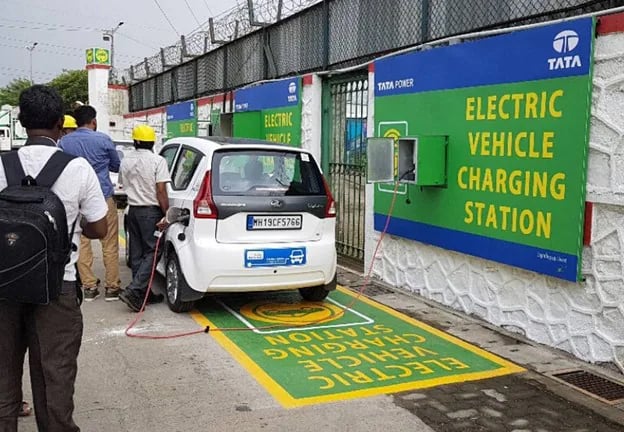The Implementation Inadequacy of EV Policy in India
The transition from conventional internal combustion engine vehicles to electric vehicles (EVs) faces significant obstacles, both institutional and environmental. Despite hurdles like cost and policy variability, the future of EVs in India holds promise amid burgeoning interest and industry investments.


The transition from conventional internal combustion engine vehicles to electric vehicles (EVs) faces significant obstacles, both institutional and environmental. Despite being introduced to reduce carbon emissions and support environmental conservation, EVs have encountered challenges such as allegations of non-environmentally friendly battery manufacturing. Moreover, the sudden shift post-COVID has posed difficulties for consumers. Yet, EV sales have surged, reflecting a growing public acceptance. This sector's growth sparks debates on government policies, consumer impacts, and manufacturing opportunities. While some states incentivize EV adoption through subsidies and tax exemptions, disparities exist, hindering uniform promotion nationwide. Despite hurdles like cost and policy variability, the future of EVs in India holds promise amid burgeoning interest and industry investments.
The road from conventional combustion engine vehicles to electric vehicles is filled with many obstacles. These obstacles are not only institutional but also largely affect the underlying objective of introduction of electric vehicles. The electric vehicles were introduced to reduce the carbon emissions from these vehicles and support the government initiative of conservation of environment but the recent allegations that batteries used in electric vehicles are manufactured using fossil fuel energy clearly hampers the idea of clean energy. The disposal of used batteries are also under radar for not having a proper disposal procedure and incineration being the only option available. The recent inclination in the consumer market towards EVs have also caused a lot of trouble to the consumers because of economic shock due to the complete lockdown, and announcements by the Ministry of Road and Transport to promote a switch from fossil fuels as mentioned on e-AMRIT, that India is ambitious to achieve about 40 percent cumulative electric power installed capacity from non-fossil fuel-based energy resources by the year 2030seemed difficult in the current post-COVID era.
In contrast to the above discussion the sales for electric vehicles have gone to the roof, the recent sales figures published by EV-reporter have shown that electric vehicle sales have risen from 1,11,355 units in April 2023 to 1,14,910 units in April 2024, this 3.2% rise in sales figures have justified that the public is slowly moving towards the idea of electric vehicles. This transition towards a new sector opens up a lot of scope for debate and deliberation. The EV policy of the central and state governments has to be put under the lens to observe its impact on the consumers. These policies can also be studied from a manufacturer's point of view as we may see a lot of new entrepreneurs stepping into this domain. The market of Electric vehicles can be analyzed from two perspectives initially from a consumer perspective and from a manufacturer’s perspective, to dive deep into this analysis we could rely on the data provided by e-Amrit website of Government of India. As a precursor to analysis we could assume that the central government subsidies on EV vehicles particularly classified on the basis of battery size is common for all the states in the country to facilitate a common ground for comparison among the states. The central government policies do provide some assistance to the consumers but the initiatives of the states can't be ignored keeping in mind the initiatives of the states have major role to play in shaping this sector within their respective regions.
If we analyze from a consumer point of view we can deduce that not all the states have taken initiative for promoting the electric vehicles in their respective regions. There are only fifteen states that have taken steps to promote electric vehicles, these States have either provided subsidies or exemptions in multiple ways like vehicle tax, registration, state GST and road tax. On analyzing the state wisemanufacturing and consumer data of electric vehicles given on the e-Amrit website, we can conclude that states like Maharashtra, Madhya Pradesh, Uttar Pradesh, TamilNadu, Kerala and Telangana have offered exemptions on registrations of the electric vehicles and also provided subsidies on road tax and few of the states have also provided capital subsidy on the purchase of electric vehicles. Andhra Pradesh is the only state that has provided 100% exemption of state GST. Madhya Pradesh and Uttarakhand are the only states that have provided exemptions of vehicle tax for 99% and 100% respectively. These data figures may sound interesting and would generate an illusion that these States are promoting electric vehicles than the conventional internal combustion vehicles but on diving deep under these statements we can conclude that the scenario is very different than perceived. A lot of these states have declared capital subsidy on the purchase of vehicles initially, but no benefit to the consumer later on as in case of few of the states that have offered the capital subsidy for first 1000 vehicles, 2000 vehicles and so on. This initiative won't prove effective if the government's motive is to change the individuals' choices because many people would not directly switch from there conventional engine vehicles to electric vehicles without any prior confidence in that technology. The recent news about two wheeler electric vehicles catching fire under extreme heat or electric cars suddenly catching fire under the sun also places this technology under scrutiny. According behavioral economics, institutions can frame policies that can change the behavior of individuals there by impacting their decisions but in this case the policy for the promotion of these electric vehicles are not very effective because these policies are localized and time biased which would exclude consumers that have a tendency of testing the waters before entering it.
Even on the other side of the sector the light seems dim as the manufacturing of electric vehicles would surely generate good employment in the country but not a lot of avenues are generated to promote the manufacturing of electric vehicles. As per e-Amrit website data only 6 States have provided 100% exemptions on stamp duty and state GST on mega, medium and micro industries. Karnataka is the only state to provide electricity and land subsidy along with state GST and stamp duty exemptions. Tamil Nadu, Telangana, Uttar Pradesh and Uttarakhand have also generated avenues to promote manufacturing of electric vehicles in their particular States but amazingly not much interest is shown by Maharashtra, being one of the hubs of manufacturing in the past. Provision of these benefits by the state governments are also important for the manufacturing companies because these subsidies could lower down the prices of these vehicles and would exert less pressure on the consumer. This sector could be the turning point in the race of becoming the world's manufacturing hub as the automobile sector is a large domain with important players like Tata and Mahindra that have already dominated the domestic market and foreign players like Kia, Hyundai and Toyota that are seeding deep into the automobile sector in India.
The future for electric vehicles in India looks bright but not without hindrances like expensive cost, experimenting policies and individual interest in this sector. We have seen many established tech giants entering this sector and many upcoming companies like Ather and BYD dominating the two wheeler and four wheeler market respectively.
References:
1. Government approves E-Vehicle policy to Promote India as a Manufacturing Destination for e-vehicles. (n.d.). https://pib.gov.in/PressReleasePage.aspx?PRID=2014874
2. e-AMRIT. (n.d.). National Level Policy on Electric Vehicles. e-amrit.niti.gov.in/national-level-policy. Retrieved June 12, 2024, from https://e-amrit.niti.gov.in/national-level-policy
3. e-AMRIT. (n.d.-b). State Level Policies on Electric Vehicles. e-amrit.niti.gov.in/state-level-policies. Retrieved July 17, 2024, from https://e-amrit.niti.gov.in/state-level-policies
4. Anuradha. (2024, May 6). India’s Electric Vehicle sales trend | April 2024 • EVreporter. EVreporter. https://evreporter.com/indias-electric-vehicle-sales-trend-april-2024/
5. e-AMRIT. (n.d.-a). BENEFITS OF ELECTRIC VEHICLES. e-amrit.niti.gov.in/benefits-of-electric-vehicles. Retrieved July 17, 2024, from https://e-amrit.niti.gov.in/benefits-of-electric-vehicles
ABOUT THE AUTHOR
Adityavardhan is a public policy professional specializing in data science, with a strong focus on data-driven policymaking. Currently pursuing a Master of Arts in Public Policy and Governance from Tata Institute of Social Sciences, Hyderabad and a Postgraduate Diploma in Applied Statistics from IGNOU, he combines technical expertise with a commitment to impactful, sustainable outcomes. Notable projects include contributing to a World Bank study on Hyderabad’s labour market. He holds expertise in Green Industrial Policy, Lobbying and Advocacy, Impact Evaluation, EV Policy, Sustainability and Joint Risk Assessment, reflecting his interdisciplinary approach to policy analysis.


